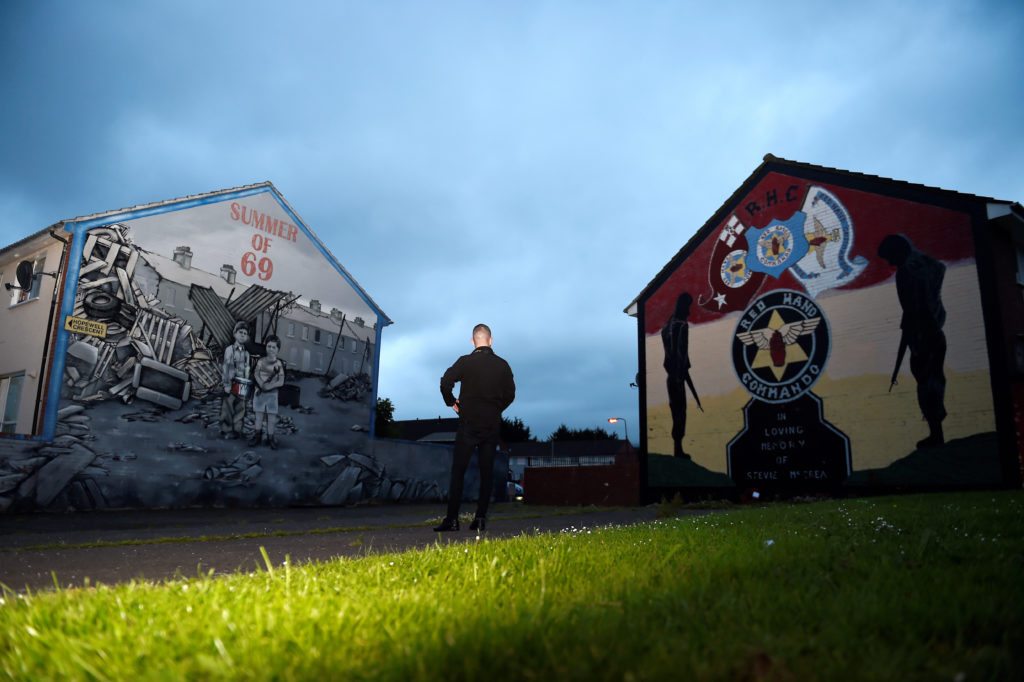360 video: Walk through Northern Ireland as it confronts the legacy of the Troubles

Twenty years after the Good Friday Agreement ended a three-decade-long conflict, the peace process in Northern Ireland is filled with starts and stops as society remains deeply divided.
In Belfast’s working-class neighborhoods, Protestant-Unionist-Loyalists, who are pro-British, and Catholic-Republican-Nationalists, who are pro-Irish, rarely inter-mix. And this February, power-sharing talks between the two dominant parties in the region’s assembly failed over several cultural sticking points, particularly funding for inquests into the murders of victims of the Troubles, same-sex marriage, and an Irish language act that would promote Gaelic on par with English in courts, government services and street signs. While the violence has subsided, the culture wars still rage.
As Colum Eastwood, the leader of Ireland’s Social Democratic and Labour Party, wrote in The Guardian, “This was not just a breakdown of a negotiation or of a relationship between two political parties – this now threatens to be a fundamental breakdown of all the progress we have achieved since Good Friday 1998.”
From the bitter memories of loss in Northern Ireland’s borderlands — the counties that sit closest to neighboring Ireland — to the “peace” walls that fracture Belfast, and on to the first generation to come of age in this period of peace, look up close at a society still working to bridge centuries-old sectarian divides.
Belfast peace walls form a ‘no man’s land’ in divided city
In Belfast, 116 interface barriers, commonly known as peace walls, continue to segregate Catholic and Protestant communities. In the form of mesh fences, brick walls, and steel gates, these walls have normalized partition as residents say they feel protected by them. But how long must they stand if Belfast is to truly recover from the Troubles? The Belfast Interface Project, a think tank that focuses on the walls, has launched an innovative virtual reality project to help prepare citizens for their removal.
Youth program brings Northern Ireland’s Protestants and Catholics into conversation
Nadia Long is a 17-year-old living in an all-Protestant neighborhood. Luighseách McMaster is an Irish-speaking 16-year-old living in a traditional Catholic neighborhood. They are part of the first generation to come of age since the peace agreement of 1998, and along with the R-City community program in Belfast, demonstrate how perceptions are changing, slowly but surely, among today’s youth.
Violence was rampant in Northern Ireland’s rural borderlands. Now, its victims are speaking up.
During Northern Ireland’s Troubles, the rural county of Fermanagh didn’t see the same level of conflict as did urban centers like Belfast or Londonderry. The violence here was impacted by the presence of the Irish border, which runs through forest, rivers and farmland along the south of the county and allowed the Provisional Irish Republican Army, or IRA, to mount attacks and quickly cross the border to safety. Many of their targets were members of the security forces: police, part-time soldiers with a local regiment and members of the British army. But civilians were murdered, too, both Catholics and Protestants. Today, one victims support group, the South East Fermanagh Foundation (SEFF), seeks to memorialize and educate the public on the heavy price this region paid during the conflict.
This project was produced by New York University’s GlobalBeat Program. Production assistance was provided by Emily Cameron, Jesselyn Cook, Summer Eldemire and Elle Luan. Jan Kobal composed music for the third video.
ncG1vNJzZmivp6x7sa7SZ6arn1%2Bjsri%2Fx6isq2enpL%2BtsI5sbWllpp6xpruMsJilo12ptbO71KCfZqafp8GpsdGnZKKqlaGur7CMmqpmoaRisLC6xaump6yjYsGpsYylnKCZk656sLKMrZ%2BeZaSnvLauy56q